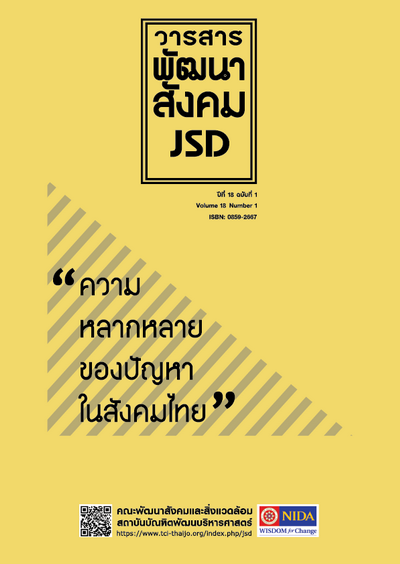ทุพพลภาพศึกษาภายใต้กระแสการท่องเที่ยวของคนพิการ Disability Study under Inclusive Tourism Trends
Main Article Content
Abstract
บทความนี้มีวัตถุประสงค์เพื่อวิเคราะห์ภาพรวมของปรัชญาและแนวคิดต่างๆที่เกี่ยวข้องกับการศึกษาคนพิการในบริบทของการท่องเที่ยวตามแนวคิดทุพพลภาพศึกษาภายใต้กระแสการเดินทางของกลุ่มคนพิการที่เกิดขึ้นในปัจจุบัน โดยบทความจะเริ่มจาก ความสำคัญของการท่องเที่ยวและสิทธิของคนพิการ ปรากฏการณ์กระแสการเดินทางของคนพิการ ฐานคิดในการศึกษาคนพิการที่เกี่ยวข้องกับการเดินทางและการท่องเที่ยว รวมทั้งอุปสรรคการท่องเที่ยวของคนพิการ ผลการศึกษาพบว่า กระแสการท่องเที่ยวของคนพิการ มีพัฒนาการที่เห็นการเปลี่ยนแปลงเป็น 3 กระแสหลัก กระแสแรกเน้นที่สิทธิของคนพิการ กระแสที่ 2 มองคนพิการเป็นตลาดการท่องเที่ยวควบคู่ไปกับสิทธิของคนพิการ และกระแสที่ 3 เป็นเรื่องของการสร้างมาตรฐานและมาตรการการท่องเที่ยวของคนพิการ สำหรับแนวคิดในการศึกษาคนพิการในบริบทของการท่องเที่ยวนั้นพบว่ามี 2 รูปแบบคือรูปแบบเชิงการแพทย์ และรูปแบบเชิงสังคม โดยรูปแบบเชิงการแพทย์จะใช้การท่องเที่ยวและนันทนาการเป็นเครื่องมือในการรักษาและฟื้นฟูร่างกายหรือจิตใจคนพิการให้กลับสู่สภาพปกติ และส่วนใหญ่จะปรากฏอยู่ในศาสตร์ด้านวิทยาศาสตร์การกีฬา ส่วนรูปแบบเชิงสังคมถือเป็นแนวคิดในทุพพลภาพศึกษาที่แบ่งออกเป็น 2 แนว โดยในแนวแรกจะเน้นถึงความเสียเปรียบและความไม่เท่าเทียมกันในสังคมที่มีต่อคนพิการโดยไม่กล่าวถึงประเด็นทางการแพทย์ ส่วนแนวที่สองจะเน้นที่ความสัมพันธ์ระหว่างคนพิการกับสังคมและให้ความสำคัญในการค้นหาอุปสรรคและสิ่งกีดขวางที่เกิดขึ้นแก่คนพิการในการเดินทางและการท่องเที่ยวโดยไม่ปฏิเสธรูปแบบทางการแพทย์ในการค้นหาความต้องการด้านอุปกรณ์การช่วยเหลือและสิ่งอำนวยความสะดวกตามความจำเป็นที่ต่างกันของความพิการ
This research aimed to analyze the philosophy and concepts related to disability studies in the context of current tourism trends. The importance of tourism, disability rights, emerging trends of disability tourism, fundamental idea of disability studies associated with travelling and tourism, and barriers faced by disabled tourists were studied and discussed. The results suggested that the emerging trends of disability tourism mainly focused on the following: 1) disability rights, 2) disability tourism market and disability rights, 3) disability tourism standards and measures. It was also found that the concepts of disability tourism could be divided into medical and social models. Considering medical model, tourism and recreation were applied as a tool to treat and rehabilitate disabled tourists physically and mentally. This model appeared mostly in the context of sport science. As for the social model, it could be categorized into two dimensions. The first dimension focused on disadvantage and inequality among people with disabilities without mentioning medical issues. On the other hand, the second dimension emphasized the social relationship among people with disabilities and also placed an importance on disabling barriers that obstructed the participation of disabled tourists. This model adopted medical methods to explore the demand for supportive equipment and facilities of people with different disabilities.


